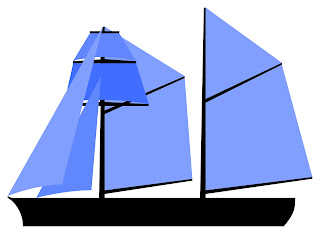The next set of sailing vessels, following logically from the single-masted vessels, will be those with two masts. Just as a recap, there were some vessels touched on in the last post that could have more than one mast, the caravel and the lugger. Two masted versions will tend to be a little bigger, and will suffer a little from wind shadow (where the sails on the forward mast are at least partially blocked from the wind by the sails on the after mast) when sailing directly downwind.
There was another type that I overlooked last time, or maybe I intentionally left it out and don't remember why; this one is the felucca. Feluccas were lateen-rigged ships (a type of fore-and-aft rig originating in the eastern Mediterranean) with 1-3 masts. If I can find anything that sets lateen sails apart from any other fore-and-aft rigging scheme, I'll get around to developing those details into game mechanics, but for now, feluccas will probably be grouped in with another type of vessel for game purposes.
- Brig
 |
| Refundpolitics, CC BY-SA 3.0 <https://creativecommons.org/licenses/by-sa/3.0>, via Wikimedia Commons |
A brig's main allotment of sails includes square sails on both masts, but also a fore-and-aft gaff sail on the mainmast (situated to the rear with a foremast in front) and headsails. Their heavy use of square sails gives them speed at sea, where winds are generally strong and blow steadily from one direction, but the fore-and-aft sail and headsails offer maneuverability and better handling along coasts where winds can be light and variable. Brigs can be quite large and tend to require larger crews to handle all these sails.
- Yawl
 |
| By Casito at the English-language Wikipedia, CC BY-SA 3.0, https://commons.wikimedia.org/w/index.php?curid=2543192 |
A yawl has most of its sail area on the mainmast, with a much smaller sail on its mizzen mast, situated far to back of the ship, generally behind the rudder post. All sails are fore-and-aft. Yawls are easily handled by smaller crews.
- Ketch
 |
| By Casito at the English-language Wikipedia, CC BY-SA 3.0, https://commons.wikimedia.org/w/index.php?curid=2543154 |
A ketch is very similar to a yawl, with fore-and-aft sails on a large mainmast and a much smaller mizzen. The mizzen mast of a ketch is before the rudder post (not as far back as a yawl's). As a war vessel, ketches are usually equipped with a mortar on the deck ahead of the mainmast, and used to bombard shore installations. Such a vessel is referred to as a bomb ketch.
 |
| Refundpolitics, CC BY-SA 3.0 <https://creativecommons.org/licenses/by-sa/3.0>, via Wikimedia Commons |
The brigantine is similar to the brig, with square sails on the foremast, and a gaff-rigged mainsail with at least one square-rigged topsail above it on the mainmast. (The difference is that the brig has a square mainsail with a small gaff sail right behind it, and a brigantine has a gaff mainsail with no square sail in that position.) Brigantines are relatively fast and maneuverable, making them a good all-around rig, equally suited to coastal work and the open sea.
 |
| By Casito - https://en.wikipedia.org/w/index.php?title=File:Sail_plan_brigantine.svg, CC BY-SA 1.0, https://commons.wikimedia.org/w/index.php?curid=22001195 |
Similar to the brig and brigantine, the hermaphrodite brig or schooner brig has a square-rigged foremast and and fore-and-aft rigged mainmast, without square topsails.
 |
| By Casito at the English-language Wikipedia, CC BY-SA 3.0, https://commons.wikimedia.org/w/index.php?curid=2543169 |
Schooners have two or more masts, all rigged fore-and-aft. They're common vessels for coastal trading. The rig can be handled with a small crew (important for commercial shipping, and also because winds just off shore can be highly variable, requiring frequent adjustment), and is handy sailing upwind.
 |
KDS444, CC BY-SA 3.0 <https://creativecommons.org/licenses/by-sa/3.0>, via Wikimedia Commons
|
As a schooner, but with square topsails situated above the fore-and-aft sails on one or more masts. The square topsails require more crew to set, but provide better speed in steady, more-or-less downwind directions than fore-and-aft sails alone.







No comments:
Post a Comment